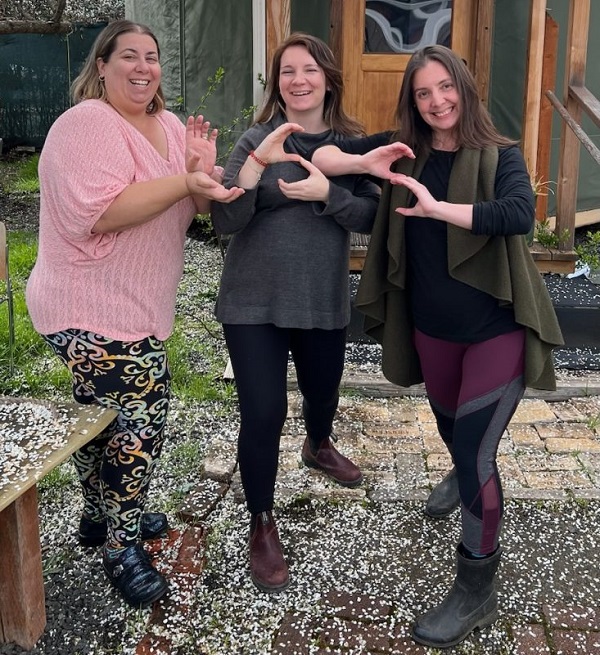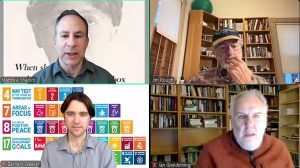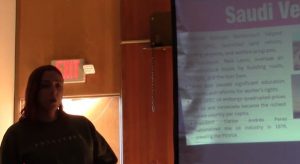Community Supported Shelters offers consulting services
11 min read
Local activists hoping to stop the sweeps invited Community Supported Shelters to talk about what it takes to operate a shelter site.
Heather Quaas-Annsa (CSS): Hi. My name is Heather Quaas-Annsa. I am the director of philanthropy for Community Supported Shelters. Our organization believes that building community is the key that supports a person transitioning from desperation to having confidence in oneself and their surroundings.
[00:00:25] Inside each of our sites is an intentional community where people are invited to rebuild a personal support network, practice respect for themselves and others, and gain confidence by reaching their own individualized goals.
[00:00:36] We provide our clients with support through navigation services that encourage stabilization and the will to rebuild their lives.
[00:00:45] Tabitha Eck (CSS): I’m Tabitha. I’m the operations director. Our organization wasn’t founded initially with the chronically unhoused people in mind. This was intended for all kinds of human groups to build intentional community inexpensively with shared resources. It is meant to be mobile and adapt to community needs. It just so happens in Eugene, the need became homelessness. And so the city tapped us and we expanded rapidly. And now you see CSS as it is today, with 14 sites and working with hundreds of chronically unhoused individuals. So, it’s been a pretty radical 10 years for Eugene’s unhoused community.
[00:01:29] Heather Quaas-Annsa: Over the last decade, Community Supported Shelters has developed durable and low-cost Conestoga huts to give our clients safe and private dwellings inside our ‘Safe Spot’ communities. Those are also known as rest stops for the City of Eugene’s rest stop program.
[00:01:44] At this point, CSS manages 14 Safe Spot communities throughout the city of Eugene, with about 143 huts in total that are available for occupancy.
[00:01:53] Each site has a kitchen with stoves, stainless steel countertops, porta-potties, a common meeting space with a wood stove, and solar-powered charging stations for small electronic devices. The sites are fenced and locked. Security is maintained by the community members.
[00:02:09] A complete camp of 18 huts, plus the infrastructure, using extensive volunteer labor with free use of city property for a site, cost us about $135,000 to build in April of 2021. The cost of providing our clients with shelter and support through our program is just over $7,000 per year.
[00:02:29] And according to the National Alliance to End Homelessness, a chronically homeless person costs the taxpayer an average of just under $36,000 a year, and that was data from 2017, so our program is definitely a lot more cost-effective than just allowing someone to continue to try to survive on the streets.
[00:02:48] All people need safe, accessible, legal places to be, both at night and during the day, and a place to securely store their belongings until permanent housing is found.
[00:02:57] As I’m sure most people are aware, the primary cause of homelessness continues to be the lack of affordable housing in the area, and that’s stemming from both a shortage of units and from rents rising faster than people’s wages are rising.
[00:03:10] Encampments have also increased because people can’t access shelter beds. CSS, for example, has about a three- to four-month waiting list at this point. Some individuals also have objections to the requirements that some local shelters have, like the need to relinquish their pets and personal belongings.
[00:03:26] Other people see that tent encampments offer more of an opportunity for privacy and safety than shelters do. There are some instances where being in a shelter does increase your likelihood of being assaulted or having your stuff vandalized or stolen or just feeling unsafe in general, based upon your personal past traumas.
[00:03:47] To be clear, encampments can and do play a role in addressing the homelessness crisis but they’re not a viable long-term solution to housing all individuals. Sanctioned encampments serve as an intermediary step, making it easier for individuals experiencing unsheltered homelessness to live with dignity while they become connected to organizations that can support them until more permanent housing is available.
[00:04:12] The question then becomes: What are we looking to do? Are we planning and budgeting for how people staying in these tent sites are going to be able to exit homelessness and access permanent housing?
[00:04:22] And that’s sort of the question that I would like to pose to the community at large. Creating sanctioned encampments may make it look and feel like the community is taking action to end homelessness on the surface, but by themselves, encampments really have little impact on actually reducing homelessness.
[00:04:38] Ultimately, access to stable housing that people can afford, with the right level of services to help them succeed, ends homelessness. People staying within encampments are still unsheltered, they’re still living outside, and they are still homeless.
[00:04:51] And oftentimes these settings are not providing them with a truly safe, healthy, and secure environment. So, is the intent of a tent site to keep individuals from being displaced, like from sweeps? Is it to prevent them from staying near the railroads or in parks or next to the river, or is it to help them move from the street into housing?
[00:05:10] So if the short-term goal is to just sort of move people away from those designated areas that people are concerned about the unhoused staying, you really need to think about reducing the wear and tear on existing encampment sites and helping the individuals relocate to a managed shelter site like something like Community Supported Shelters does: Everyone Village, Opportunity Village, Nightingale, some sort of already managed site.
[00:05:34] And this could be like moving from a tent site into one of those. The tent sites are a better alternative than living alone, but from a facilities/cost perspective, tents are only usable for one season, if that, due to wear and tear, and that’s only if you’re planning on using them at night. So if you are going to do a tent site, you’re going to have to purchase tents every single year, potentially multiple times a year.
[00:06:00] Self-governing and self-managed communities can work. We’ve seen those work in areas such as Portland. Let’s be clear, ‘self-managed’ is often a euphemism for understaffed and underresourced. If the long-term goal is to accommodate the habitation of homeless individuals or homeless community on a designated site, then the goal is, you need to reduce the impacts to the site that results from the homeless encampment.
[00:06:24] We all know what happened at Washington Jefferson Park. That is something that wasn’t well-managed because of the resulting mess that was left and the damage that occurred. And it’s not the fault of the people that were staying there necessarily. This was not something that was thought of to be a long-term solution and it ended up being a long-term thing.
[00:06:46] So site designs and features should support its function as a shelter. Tents or places to park vehicles make sense. If you add common spaces like kitchens or meeting spaces, it turns into a more of a permanent living arrangement for individuals, not a steppingstone.
[00:07:01] So if you are looking at doing some sort of tent encampment, like some of the proposals that we’ve been hearing out in the community, a basic minimum level of infrastructure does need to be provided. You need port-a-potties, you need trash services, you need water, even if it’s only for hand-washing purposes. That’s really smart from a health perspective. Maintaining a hygienic environment is going to be challenging if they’re lacking sanitation facilities.
[00:07:25] Additionally, the site needs to be close to other available services and/or public transit. You can’t have people living out in the middle of the woods and expect them to be able to continue to subsist like that.
[00:07:35] If it’s outside, which it will be, rodents and other pests are going to be a problem. Measures to control the issue needs to be in place from the beginning. Rat poison is not an answer, that just causes more environmental problems.
[00:07:48] So those are things that you need to think about.
[00:07:51] If you were to do a dusk-to-dawn type site that’s going to reduce the wear and tear on the location. But then you need to figure out if this is a place where people are setting their stuff up, and then they’re gone during the day, who’s responsible for ensuring that the property that’s left there is kept safe?
[00:08:06] How are you going to filter and choose who occupies a limited space? Is it first come, first served? Is it a waitlist? Once you’re in, do you have to show up for a bed each day? How does that all work?
[00:08:16] And then who manages the behaviors from the encampment? What happens if someone’s a danger to themselves or to others or to the greater community? What type of security is going to be there?
[00:08:25] The unhoused are often more vulnerable to victimization and such sites can be targets for illegal activities like drug sales and human trafficking.
[00:08:33] Without navigation support, these individuals are unlikely to move from the streets into traditional housing.
[00:08:40] And some of these unhoused individuals are not going to be interested in residing in any sanctioned site. This is not going to solve the issue of individuals illegally camping. This is just a band-aid on the problem.
[00:08:51] And finally, the last thing, I highly recommend anyone that’s trying to come up with solutions on how to support the unhoused: If you haven’t talked to an unhoused individual about what it is they need, what it is they want, what would be supportive to them, please do so. Homeless people are the experts of their own condition. If you haven’t been unhoused recently, if you haven’t spoken to an unhoused person, please don’t assume that you know what an unhoused person needs.
[00:09:17] Because being housed… And looking at the problem, like while we have good intentions, we don’t actually know what the things they’re struggling with are. And so please talk to the people that are experiencing this right now before trying to make decisions on their behalf.
[00:09:35] Tabitha Eck (CSS): There is a lot to it. It’s not about just putting up tents and letting people stay somewhere. That’s all well and good if just surviving a season is the focus, but ultimately that does not help people move on in a positive way.
[00:09:49] So lovely ideas, great intention, wonderful compassion for the human and solution seeking, but a lot of folks, they’ve never done shelter work and they’ve very rarely ever been unhoused themselves.
[00:10:02] And so we have a whole consulting side to our organization.
[00:10:09] Heather Quaas-Annsa (CSS): We do offer consultations and we’ve done consultations with groups outside of Oregon. So we’ve worked with groups in Nevada, California, Hawaii, Canada, Michigan, Minnesota to get these sort of communities set up in their neighborhoods. We would love to do more consultations and more community building like that.
[00:10:27] The quickest way to get additional shelter sites for people is for the faith communities to step in and for community groups to step in. We have huts ready to be built and we can help set up a hut for a faith community within an afternoon if that’s something that they’re interested in. And that’s actually how Community Supported Shelters started was by building the huts on the properties of different faith communities, and then they allowed the unhoused individuals to stay on their property and the faith communities then work with those individuals and provided that support that they needed to move into more permanent housing solutions in the future.
[00:11:05] So, if more faith communities throughout Lane County want to step up and build Conestoga Huts and help members of their congregation get into housing, like this is an easy thing for them to do. It’s $3,500 for a hut, which is significantly cheaper than building a tiny home or building one of the sleeping pods that Portland’s looking at doing, those are $10,000 plus.
[00:11:29] $3,500 provides you with a basic Conestoga hut. And as long as you have trash services and a toilet facility available for that individual, you are allowed to have Conestoga huts on your property per the city of Eugene code, and other city codes are now looking to be changed to allow Conestoga huts and small, tiny home facilities and sleeping pods and whatnot to be part of what is allowable on even personal property.
[00:11:58] If you’re in the city of Eugene, we can put it in your backyard. Just let us know. We are willing to work with other organizations, non profits, government officials, neighborhoods, to establish sanctioned encampments or help determine where the unhoused can legally camp in Lane County without the fear of being swept.
[00:12:15] We’re constantly trying to strategize how we can be more effective. And what we can do to really support our clients and like we are involving our clients in these discussions, they are the experts of their own story and so we need like when we have clients tell us it would be great if we had X, Y, and Z like shade is a thing right now that we desperately need in our communities with the land we were given doesn’t have natural shade and so we are looking at what we can do to provide more shade so people can be more comfortable in their own communities during the, You know, we’ve got a long summer now. We’re hitting in the 90s this week.
[00:12:53] So things like that, like, you know, I, I look at our communities and think, ‘Oh, they need X, Y, and Z,’ but I’m not living there 24-7. So it’s all about just helping people where they’re at and figuring out what we can do to improve their lives and make things easier and what sort of services we give them to help them progress to the next part of their journey.
[00:13:18] Yeah, lots of things to think about and I don’t want to dissuade people from continuing to talk about this and having ideas and discussing possible solutions, because it’s just going to take one person that throws out an idea that none of us ever thought of, to change the way we are doing things.
[00:13:34] And that’s the great thing about having multiple eyes and multiple people looking at what solutions are out there and what is realistic and viable for the community at large. So I don’t want to dissuade people from throwing ideas out there and, you know, just continue to do that, continue to advocate.
[00:13:51] This problem is not going away. It took decades to make. It’s going to take decades and more for it to be solved. But it’s. I think it’s good that people are throwing out their ideas and coming trying to come up with solutions that are that even if they seem viable on the surface and then deeper dives show maybe it’s not going to work, like, that doesn’t mean it won’t work for a different community, or it won’t work for a short amount of time.
[00:14:16] So I don’t want to dissuade people from continuing to advocate for real change in this community.
[00:14:22] John Q: Gather friends to raise $3,500 and sponsor a Conestoga hut. Or bring your shelter ideas to a consultation with Community Supported Shelters.






